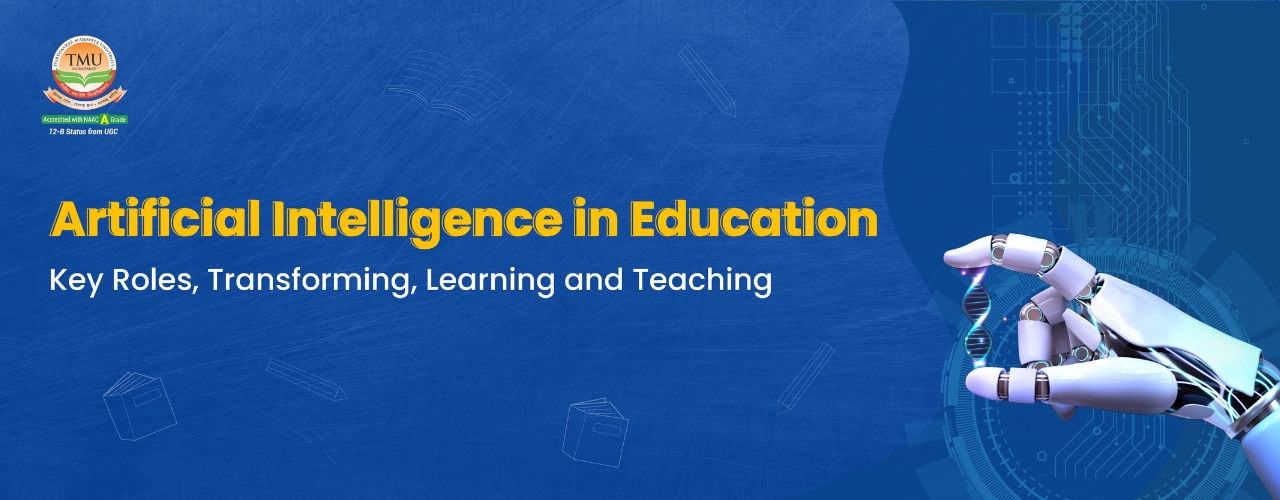Artificial Intelligence in Education: Key Roles, Transforming, Learning, and Teaching
Table of Contents
Artificial Intelligence (AI) is rapidly transforming various industries and education. AI-powered tools and technologies are revolutionising how students learn and teachers teach, offering personalised, adaptive, and engaging learning experiences.
Benefits of AI in Education:
- Personalised Learning:Tailored instruction to meet individual needs.
- Improved Students’ Engagement:More interactive and engaging learning experiences have improved students’ engagement.
- Increased Access to Education:AI-powered tools can help bridge the digital divide and provide access to quality education for students in remote areas.
- Enhanced Efficiency:Automating tasks can save teachers time and allow them to focus on more meaningful interactions with students.
- Data-Driven Insights:AI can provide valuable data on student performance and identify areas for improvement.
Overview of Artificial Intelligence in Education
Artificial Intelligence (AI) is revolutionizing various industries and education. By leveraging AI technologies, educators can enhance learning experiences, personalize instruction, and improve educational outcomes.
Feature | Benefits | Challenges |
Personalized Learning | Tailored instruction, improved engagement | Data privacy concerns |
Intelligent Tutoring Systems | Virtual guidance, feedback | Human element replacement |
Adaptive Assessments | Accurate assessment, personalized learning | Bias in algorithms |
Automated Grading | Streamlined process, teacher time | Human feedback reduction |
Administrative Tasks | Efficiency, teacher focus | Job displacement |
Language Learning | Interactive practice, personalized paths | Data privacy concerns |
Overall Benefits
- Improved learning outcomes
- Increased engagement
- Enhanced accessibility
- Reduced teacher burden
Overall Challenges
- Data privacy concerns
- Bias in algorithms
- Human element replacement
- Job displacement
Teerthanker Mahaveer University
Apply for Admission
Click Here To Apply for Admission
AI-Based Tutoring Systems in Education
AI-based tutoring systems, also known as intelligent tutoring systems (ITS), are revolutionizing the way students learn. These systems leverage artificial intelligence to provide personalized, adaptive, and interactive learning experiences.
Key Features of AI-Based Tutoring Systems
- Personalized Learning:ITS can adapt to individual student's learning styles, paces, and needs, providing tailored content and support.
- Adaptive Assessments:These systems can continuously assess students' understanding and adjust the difficulty level of questions accordingly.
- Intelligent Feedback:ITS can provide specific and actionable feedback to help students identify and correct their mistakes.
- Natural Language Processing:ITS can understand and respond to students' questions and statements in natural language.
- Interactive Simulations:These systems can provide hands-on learning experiences through simulations and games.
Examples of AI-Based Tutoring Systems
- Khan Academy:This popular online learning platform uses AI to personalize learning paths and provide adaptive practice.
- ALEKS:A math and science learning platform that uses AI to assess students' knowledge and provide targeted instruction.
- Duolingo:A language learning app that uses AI to provide personalized lessons and interactive practice.
Artificial Intelligence in Virtual Classrooms
Artificial Intelligence (AI)is revolutionizing the way we learn, and virtual classrooms are at the forefront of this transformation. By integrating AI technologies, educators can create more personalized, engaging, and effective learning environments.
Key Applications of AI in Virtual Classrooms:
- Personalised Learning Paths:AI algorithms can analyze student data to create customized learning paths tailored to individual needs, strengths, and weaknesses.
- Intelligent Tutoring Systems:AI-powered tutors can provide real-time feedback, answer questions, and offer additional explanations, mimicking the role of a human instructor.
- Adaptive Assessments:AI can generate assessments that adapt to a student's performance, ensuring that they are neither overwhelmed nor underwhelmed by the material.
- Natural Language Processing:AI-enabled tools can understand and respond to student questions and comments in natural language, fostering more interactive and engaging discussions.
- Virtual Reality (VR) and Augmented Reality (AR):AI can enhance VR and AR experiences in virtual classrooms, providing immersive and realistic simulations of real-world scenarios.
AI for Automating Administrative Tasks in Schools
Artificial Intelligence (AI) is revolutionizing various industries, and education is no exception. In schools, AI can streamline administrative tasks, freeing up educators' time to focus on what they do best: teaching and nurturing students.
Key Applications of AI in School Administration
Application | Benefits | Challenges |
Student Enrollment and Management | Streamlined process, accurate records | Data privacy concerns |
Scheduling | Optimized schedules, efficient resource allocation | Complexity of scheduling |
Resource Management | Efficient inventory management, cost savings | Technical challenges |
Financial Management | Accurate financial data, improved efficiency | Cost of implementation |
Communication | Enhanced communication, instant answers | Technical issues |
Data Analysis | Data-driven decision-making improves efficiency | Data privacy concerns |
Benefits of AI in School Administration
Benefit | Explanation |
Increased Efficiency | Automation of repetitive tasks, streamlined processes |
Cost Savings | Reduced manual labour, improved resource allocation |
Improved Accuracy | Reduced errors, enhanced data integrity |
Enhanced Data Insights | Data-driven decision-making informed planning |
Improved Communication | Enhanced communication with stakeholders, instant answers |
Challenges and Considerations
Challenge | Explanation |
Data Privacy | Protecting sensitive student and staff data |
Cost | Initial investment in AI technology and infrastructure |
Resistance to Change | Overcoming resistance from staff |
Technical Issues | Ensuring compatibility and reliability of AI systems |
Ethical Considerations of AI in Education
As artificial intelligence (AI) plays an increasingly prominent role in education, it is crucial to consider the ethical implications of its use. Here are some key ethical considerations:
Data Privacy and Security
Consideration | Explanation |
Student Data | Protecting sensitive student information |
Data Breach | Preventing and responding to data breaches |
Bias and Fairness
Consideration | Explanation |
Algorithmic Bias | Avoiding biases in AI algorithms |
Equity | Ensuring fair treatment for all students |
Human-AI Interaction
Consideration | Explanation |
Empathy and Emotional Intelligence | Balancing AI with human interaction |
Digital Divide | Addressing access disparities |
Accountability and Transparency
Consideration | Explanation |
Explainability | Understanding AI decision-making |
Human Oversight | Ensuring the ethical use of AI |
Educational Equity
Consideration | Explanation |
Access | Ensuring equal access to AI-powered tools |
Quality | Improving educational quality for all students |
Challenges of Artificial Intelligence in Education
While AI offers immense potential to transform education, it also presents several challenges that must be carefully addressed:
Technical Challenges
- Data Quality and Quantity:The effectiveness of AI algorithms depends on the quality and quantity of data they are trained on. Ensuring access to high-quality, unbiased data can be challenging.
- Computational Power:AI models require significant computational resources, which can be a barrier for schools with limited budgets or infrastructure.
- Interoperability:Integrating AI tools with existing educational systems and platforms can be complex and time-consuming.
Ethical Challenges
- Bias and Fairness:AI algorithms can perpetuate biases present in the data they are trained on, leading to unfair or discriminatory outcomes for students.
- Data Privacy:The use of AI in education raises concerns about data privacy and security, particularly when dealing with sensitive student information.
- Human-AI Interaction:AI should not replace human interaction and connection in education. It should be used to augment, not replace, human teachers.
Educational Challenges
- Digital Divide:AI-powered tools may not be accessible to all students, particularly those in rural or disadvantaged areas.
- Teacher Training:Educators may need specialized training to effectively use and integrate AI tools into their teaching practices.
- Resistance to Change:Some teachers and administrators may resist the adoption of new technologies, fearing disruption or job loss.
Conclusion
Artificial Intelligence (AI) has the potential to revolutionize education by providing personalized, engaging, and effective learning experiences. While AI offers immense benefits, it is essential to address the challenges and ethical considerations associated with its use. By carefully considering the technical, ethical, and educational implications of AI, we can harness its power to create a more equitable and effective learning environment for all students.
Frequently Asked Questions (FAQs)
Q1: How is artificial intelligence used in education?
Ans: Artificial Intelligence (AI) is revolutionizing education.It personalizes learning, provides intelligent tutoring, automates grading, adapts to student needs, and enhances language learning through virtual reality. AI offers tailored instruction, improved engagement, wider access, and valuable insights for educators.
Q2: What are the 4 types of AI technology?
Ans: AI technology is categorized into four types:reactive machines, limited memory, theory of mind, and self-awareness. Reactive machinesare the most basic, lacking memory and learning capabilities. Limited memorymachines can access past data but cannot learn from new experiences. Theory of mindinvolves understanding the mental states of others, crucial for natural language processing. Self-awareness, the highest level, is currently theoretical and involves consciousness and self-understanding.
Q3: What is AI and example?
Ans: Artificial Intelligence (AI) is the development of computer systems that can perform tasks typically requiring human intelligence.
Examples include virtual assistants, recommendation systems, self-driving cars, medical diagnosis, and language translation. AI is transforming various industries and improving efficiency in many areas.
Q4: What is AI used for today?
Ans: Artificial Intelligence (AI) is used for a wide range of applications today, including natural language processing, computer vision, recommendation systems, healthcare, finance, customer service, manufacturing, and transportation.As AI technology continues to advance, we can expect to see even more innovative and impactful uses in the future.















